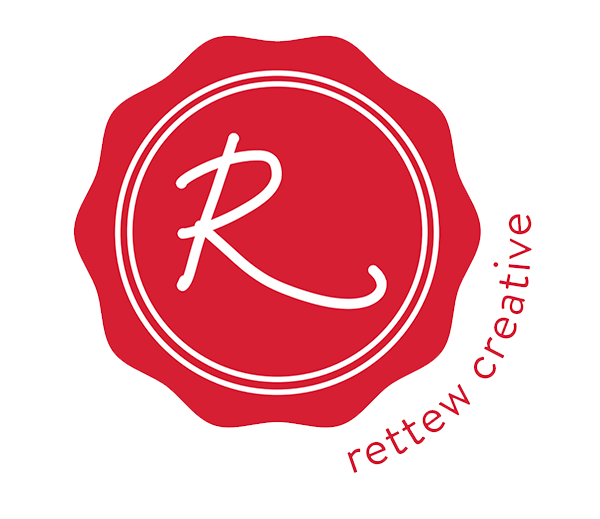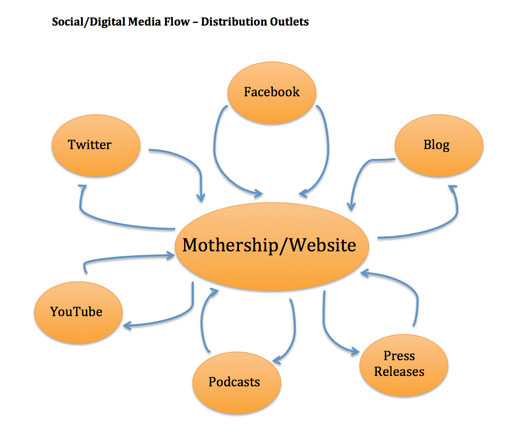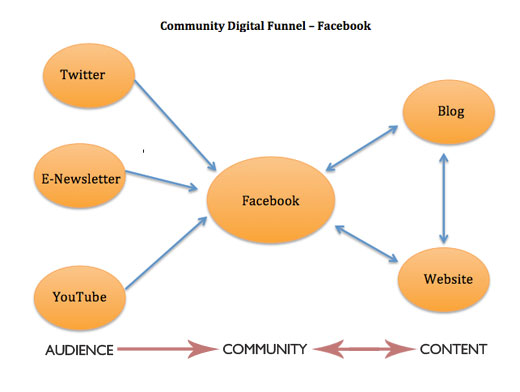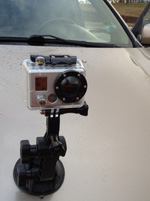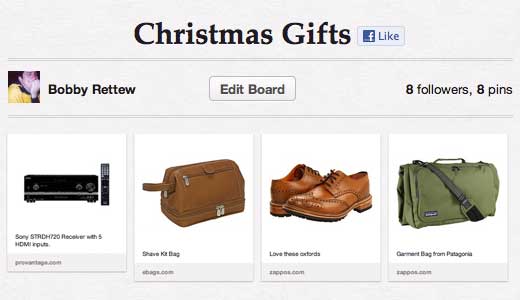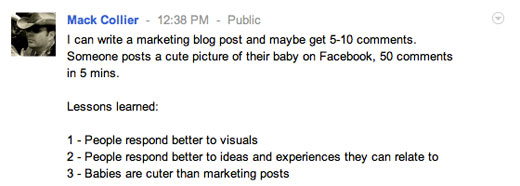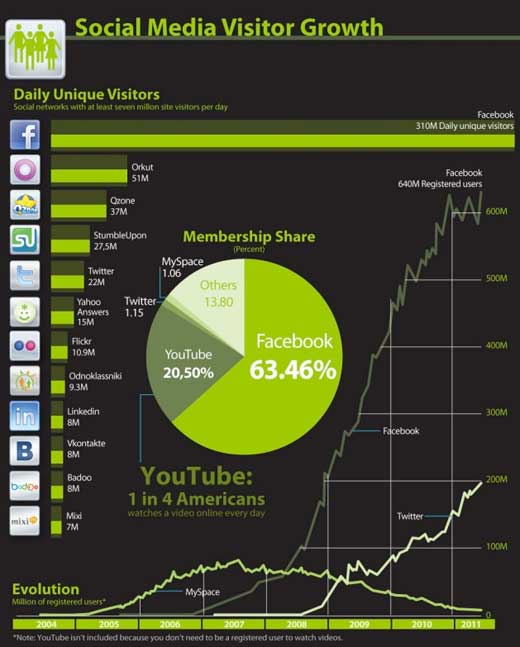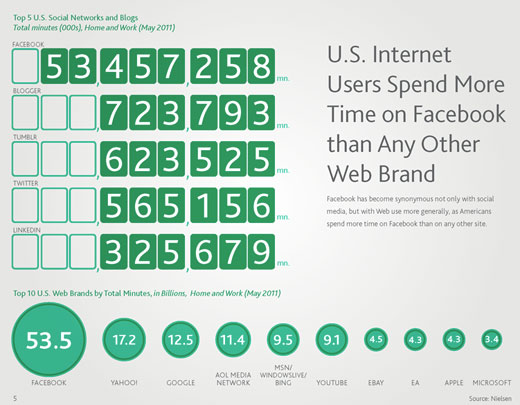I am always thinking through how to find new ways to share stories and funneling like minded people to your story. The digital road map is important, especially when you have many communities online and great stories to tell. The goal is get people to share…basically take part in digital word-of-mouth.
For the last few years, I had the opinion that you should always make your website your mothership…but recently I have really began reconsidering this opinion. For one thing, it is all about audience! But…the delivery mechanism/channel is always a part of this equation…which leads me broaden my opinion with some new options.
If you look at this diagram…you will see that the information and audience flow is to build communities based on content/information in your social/digital spaces…driving them to your mothership (website). This is a simplistic view of how a B2C organization can capture audiences, distribute information, build conversation, and drive traffic back to the mothership. But what and how is a traditional website really serving your audiences especially in the world of dynamic content?
I am finding more and more people are using social outlets as their mothership, to capture and engage audiences then direct them to a final destination for final information. But, if the final spot is your website…what are we doing to deliver the information that provides the return on engagement? Why not keep them in the dynamic content area, where the community is thriving.
Two years ago, Sally Foister of Greenville Hosptial System looked at me and said something that has stuck with me…every B2C organization should a Facebook presence. Five years ago, that statement was applied to every B2C organization should have a website. Now the trick is to drive traffic to a destination point that is not the end destination but a dynamic portal that continually engages the audience with some action.
We are going to see some interesting movement in 2012 especially with Facebook planning a $100 Billion IPO. Let’s consider some stats surrounding Facebook:
- 800 Million Users
- 1 Trillion Page Views
- October 2011 – Facebook reached more than half (55 percent) of the world’s global audience and accounted for 1 in every 7 minutes spent online around the world and 3 in every 4 social networking minutes. (via ComScore.com)
So instead of thinking in terms of driving traffic to one mothership…how about funneling traffic through Facebook. Basically use Facebook as the community funnel of information, capturing the audience in one dynamic, community driven hub.
So let’s look at some of the reasons, well I mentioned the statistics above.
First – One of the first reasons is the Timeline which has aimed to make Facebook the destination for all media. People are able to dynamically post all types of media right inside the Facebook Timeline making it easier to interact with the media and the community that surrounds the person/brand that posts the media.
Second – The Insights area for brand pages. The Insights tool provides publishers who use Facebook plugins with analytics on how content is performing. Now they can see those analytics in real time. You can see how “Like” button’s perform and the interactions based on demographics,which may enable site owners to target specific audiences.
Third – The Ticker which is the update to the News Feed. This serves as a “real-time feed of activity away from Facebook. Taken in tandem, these updates indicate Facebook’s growing desire to be to discovery what Google is to search — that is, the market leader for the new dominant form of currency on the web.” Facebook does not want to be a creator of media, they want to be the ultimate curator of media.
Fourth – The idea of expanding Gestures. They want to expand the “Like” button to developers allowing them to create concepts like “Watched, ” Listened,” Read,” and other buttons. “These actions are the next step in integrating Facebook with every part of the web. It’s possible you’ll be able to click a Facebook “Challenge” button that would let you post a game challenge on your friend’s wall, or a “Cheer” button that would let you support your friends when they need it. And yes, you could theoretically create a “Dislike” button through Facebook’s new initiative.” (via Mashable.com)
So for this model of the Community Funnel to work, you have to build a solid Facebook Community, give the community a reason to engage with one another, invite more friends, and make it easy and for the community to talk about you online.
The idea behind the community funnel is to build solid communities outside of Facebook, drive the communities to engage in Facebook, and given them a reason to want to find more information inside your mothership (web properties). Twitter, YouTube, and E-Newsletters are entry-point communities that can expose individuals to content. Then you drive this community to engage with more like-minded individuals within your Facebook presence.
Links and references used in this blog post:
http://mashable.com/2011/12/29/facebook-predictions-2012/
http://mashable.com/2011/09/22/facebook-gestures/
*** Image from MindFireInc.com
